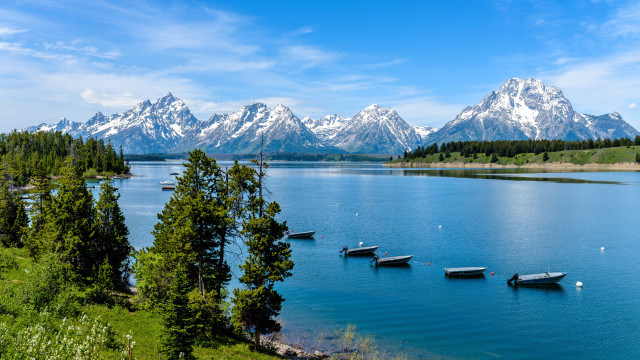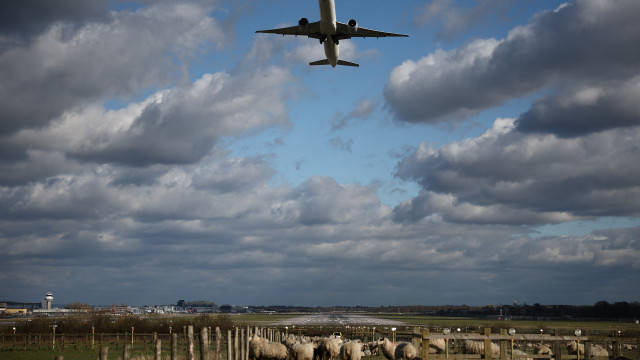




























© Shutterstock
0 / 29 Fotos
Luna moth - Striking in its size and stunning symmetry, this beautiful moth is characterized by its translucent, emerald wings stamped with conspicuous eyespots. One of the largest moths in the country, it’s found in shaded deciduous woodland.
© Shutterstock
1 / 29 Fotos
Pupa - Plump and enticing, the luna moth caterpillar is identified by the dots that run along its dorsal side, which vary in color from a light yellow to a dark magenta.
© Shutterstock
2 / 29 Fotos
Eyespots - Resembling the staring eyes of an alert animal, the moth's vivid eyespots help draw a potential predator's attention away from its vulnerable body parts. Truly a gaze to amaze.
© Shutterstock
3 / 29 Fotos
Black-footed ferret - Listed as endangered by the International Union for Conservation of Nature (IUCN), this largely nocturnal and solitary animal spends much of its time underground, in burrows made by prairie dogs. According to the IUCN, the current population numbers around 1,000 animals spread across South Dakota, Wyoming and Arizona.
© Reuters
4 / 29 Fotos
Newborns - Litter size ranges from 1–5 kits, with furry, button-eyed youngsters emerging into the big wide world at around six weeks old.
© Shutterstock
5 / 29 Fotos
Hawaiian monk seal - Found in the remote Northwestern Hawaiian Islands, this is one of the most endangered marine species in the world.
© Shutterstock
6 / 29 Fotos
Marine habitat - Their slender, torpedo-shaped physique and powerful hind flippers make them agile swimmers and formidable hunters, feeding on fish, lobster, octopus and squid in deep water coral beds.
© Shutterstock
7 / 29 Fotos
Down time - The seals breed and haul-out on sand, corals and volcanic rock, and like nothing better than to spend a little R&R slumbering in the Pacific sun.
© Shutterstock
8 / 29 Fotos
Pronghorn - Indigenous to interior western and central North America, this sure-footed species is known colloquially as the American antelope. Male pronghorns are possessed of a handsome black face mask and curvy dark horns. Females also have horns but straight in shape.
© Shutterstock
9 / 29 Fotos
Two for a pair - Unusual for the animal kingdom, twin births are common in pronghorn herds. A doe will often bring two fawns into the world at the same time, with both newborns receiving an equal share of tender loving care from mom.
© Shutterstock
10 / 29 Fotos
Gila monster
- This fearsome creature is the Gila monster ("Gila" refers to the Gila River Basin in New Mexico and Arizona), one of only two venomous lizards found in the country, the other being the Mexican bearded lizard.
© Shutterstock
11 / 29 Fotos
Menacing appearance - With a skin of bead-like scales, a broad stud-like head and boxer's jaw, the lizard enjoys a singular though somewhat menacing appearance. Sluggish on the ground but with a quick tongue, it feeds on small mammals and birds, frogs, insects and carrion.
© Shutterstock
12 / 29 Fotos
A bite to eat - So, what about that bite? It’s formidable, delivering a cocktail of neurotoxins through rows of sharp teeth that dispatch prey quickly and efficiently. While not fatal to humans, a bite will still prove an extremely painful experience.
© Shutterstock
13 / 29 Fotos
American black bear - The smallest bear species found on the North American continent, black bears are widespread and live mostly in forested areas.
© Shutterstock
14 / 29 Fotos
Join the cub - Cubs are born with fine, grey, down-like hair and are undeniably cute. They begin walking after five weeks, and soon after begin scampering over the forest floor or clambering trees in joyous displays of mischief and mirth.
© Shutterstock
15 / 29 Fotos
Bear necessities - Strong and powerful swimmers, black bears will swim for pleasure and to hunt, mostly for fish. Active at any time of day or night, this particular bear has a tendency to forage after dark.
© Shutterstock
16 / 29 Fotos
Groundhog - A member of the squirrel family, this squat, impossibly cuddly rodent is found all over the country, especially in the northeastern and central United States.
© Shutterstock
17 / 29 Fotos
Going underground - Excellent burrowers, groundhogs sleep, rear young, and hibernate underground – one of the longest known burrows measured 24 feet and featured two chambers.
© Shutterstock
18 / 29 Fotos
A long winter's sleep - Before hibernating – typically from October to April – the resourceful rodents will have piled on the pounds in order to survive the cold, harsh winter period.
© Shutterstock
19 / 29 Fotos
American alligator - Endemic to the humid, southeastern United States, this ancient reptile species is found slumbering in freshwater wetlands, typically marshes and cypress swamps.
© Shutterstock
20 / 29 Fotos
Similar but different - The alligator is distinguished from the American crocodile by a darker complexion and a broader snout, with overlapping jaws.
© Shutterstock
21 / 29 Fotos
Little snapper - A female can lay anywhere between 20 to 50 eggs, with youngsters born as miniature replicas of their parents and easily identified by the distinctive yellow stripes decorating their tiny frames.
© Shutterstock
22 / 29 Fotos
American bison - Hunted mercilessly almost to extinction in the 19th century, this noble beast thankfully remains a much cherished icon of the Midwest landscape. This is the largest mammal in North America, and the national mammal of the United States.
© Shutterstock
23 / 29 Fotos
Dominance hierarchy - The breeding season usually lasts from July to September. Interestingly, bison born earlier in the season are more likely to be larger and more dominant as adults.
© Shutterstock
24 / 29 Fotos
Where the bison roam - Custer State Park in South Dakota is a preferred location for observing bison. Here, 1,500 animals make up one of the largest herds in the world.
© Shutterstock
25 / 29 Fotos
Bald eagle - The country’s national bird and national animal (a distinction it shares with the bison), this majestic raptor remains an impressive and authoritative symbol of the United States.
© Shutterstock
26 / 29 Fotos
Nest in peace - Incredibly, the bird was on the brink of extinction in the US as recently as the latter half of the 20th century. Fortunately, populations have since recovered, and the bald eagle’s natural range covers the entire continental United States.
© Shutterstock
27 / 29 Fotos
Soaring success
- Powerful fliers and surprisingly maneuverable in the air, bald eagles can reach speeds of up to 45 mph when gliding. Their maximum dive speed is an impressive 100 mph.
© Shutterstock
28 / 29 Fotos
© Shutterstock
0 / 29 Fotos
Luna moth - Striking in its size and stunning symmetry, this beautiful moth is characterized by its translucent, emerald wings stamped with conspicuous eyespots. One of the largest moths in the country, it’s found in shaded deciduous woodland.
© Shutterstock
1 / 29 Fotos
Pupa - Plump and enticing, the luna moth caterpillar is identified by the dots that run along its dorsal side, which vary in color from a light yellow to a dark magenta.
© Shutterstock
2 / 29 Fotos
Eyespots - Resembling the staring eyes of an alert animal, the moth's vivid eyespots help draw a potential predator's attention away from its vulnerable body parts. Truly a gaze to amaze.
© Shutterstock
3 / 29 Fotos
Black-footed ferret - Listed as endangered by the International Union for Conservation of Nature (IUCN), this largely nocturnal and solitary animal spends much of its time underground, in burrows made by prairie dogs. According to the IUCN, the current population numbers around 1,000 animals spread across South Dakota, Wyoming and Arizona.
© Reuters
4 / 29 Fotos
Newborns - Litter size ranges from 1–5 kits, with furry, button-eyed youngsters emerging into the big wide world at around six weeks old.
© Shutterstock
5 / 29 Fotos
Hawaiian monk seal - Found in the remote Northwestern Hawaiian Islands, this is one of the most endangered marine species in the world.
© Shutterstock
6 / 29 Fotos
Marine habitat - Their slender, torpedo-shaped physique and powerful hind flippers make them agile swimmers and formidable hunters, feeding on fish, lobster, octopus and squid in deep water coral beds.
© Shutterstock
7 / 29 Fotos
Down time - The seals breed and haul-out on sand, corals and volcanic rock, and like nothing better than to spend a little R&R slumbering in the Pacific sun.
© Shutterstock
8 / 29 Fotos
Pronghorn - Indigenous to interior western and central North America, this sure-footed species is known colloquially as the American antelope. Male pronghorns are possessed of a handsome black face mask and curvy dark horns. Females also have horns but straight in shape.
© Shutterstock
9 / 29 Fotos
Two for a pair - Unusual for the animal kingdom, twin births are common in pronghorn herds. A doe will often bring two fawns into the world at the same time, with both newborns receiving an equal share of tender loving care from mom.
© Shutterstock
10 / 29 Fotos
Gila monster
- This fearsome creature is the Gila monster ("Gila" refers to the Gila River Basin in New Mexico and Arizona), one of only two venomous lizards found in the country, the other being the Mexican bearded lizard.
© Shutterstock
11 / 29 Fotos
Menacing appearance - With a skin of bead-like scales, a broad stud-like head and boxer's jaw, the lizard enjoys a singular though somewhat menacing appearance. Sluggish on the ground but with a quick tongue, it feeds on small mammals and birds, frogs, insects and carrion.
© Shutterstock
12 / 29 Fotos
A bite to eat - So, what about that bite? It’s formidable, delivering a cocktail of neurotoxins through rows of sharp teeth that dispatch prey quickly and efficiently. While not fatal to humans, a bite will still prove an extremely painful experience.
© Shutterstock
13 / 29 Fotos
American black bear - The smallest bear species found on the North American continent, black bears are widespread and live mostly in forested areas.
© Shutterstock
14 / 29 Fotos
Join the cub - Cubs are born with fine, grey, down-like hair and are undeniably cute. They begin walking after five weeks, and soon after begin scampering over the forest floor or clambering trees in joyous displays of mischief and mirth.
© Shutterstock
15 / 29 Fotos
Bear necessities - Strong and powerful swimmers, black bears will swim for pleasure and to hunt, mostly for fish. Active at any time of day or night, this particular bear has a tendency to forage after dark.
© Shutterstock
16 / 29 Fotos
Groundhog - A member of the squirrel family, this squat, impossibly cuddly rodent is found all over the country, especially in the northeastern and central United States.
© Shutterstock
17 / 29 Fotos
Going underground - Excellent burrowers, groundhogs sleep, rear young, and hibernate underground – one of the longest known burrows measured 24 feet and featured two chambers.
© Shutterstock
18 / 29 Fotos
A long winter's sleep - Before hibernating – typically from October to April – the resourceful rodents will have piled on the pounds in order to survive the cold, harsh winter period.
© Shutterstock
19 / 29 Fotos
American alligator - Endemic to the humid, southeastern United States, this ancient reptile species is found slumbering in freshwater wetlands, typically marshes and cypress swamps.
© Shutterstock
20 / 29 Fotos
Similar but different - The alligator is distinguished from the American crocodile by a darker complexion and a broader snout, with overlapping jaws.
© Shutterstock
21 / 29 Fotos
Little snapper - A female can lay anywhere between 20 to 50 eggs, with youngsters born as miniature replicas of their parents and easily identified by the distinctive yellow stripes decorating their tiny frames.
© Shutterstock
22 / 29 Fotos
American bison - Hunted mercilessly almost to extinction in the 19th century, this noble beast thankfully remains a much cherished icon of the Midwest landscape. This is the largest mammal in North America, and the national mammal of the United States.
© Shutterstock
23 / 29 Fotos
Dominance hierarchy - The breeding season usually lasts from July to September. Interestingly, bison born earlier in the season are more likely to be larger and more dominant as adults.
© Shutterstock
24 / 29 Fotos
Where the bison roam - Custer State Park in South Dakota is a preferred location for observing bison. Here, 1,500 animals make up one of the largest herds in the world.
© Shutterstock
25 / 29 Fotos
Bald eagle - The country’s national bird and national animal (a distinction it shares with the bison), this majestic raptor remains an impressive and authoritative symbol of the United States.
© Shutterstock
26 / 29 Fotos
Nest in peace - Incredibly, the bird was on the brink of extinction in the US as recently as the latter half of the 20th century. Fortunately, populations have since recovered, and the bald eagle’s natural range covers the entire continental United States.
© Shutterstock
27 / 29 Fotos
Soaring success
- Powerful fliers and surprisingly maneuverable in the air, bald eagles can reach speeds of up to 45 mph when gliding. Their maximum dive speed is an impressive 100 mph.
© Shutterstock
28 / 29 Fotos
Born in the USA: America’s unique wildlife
Amazing species you might not know are native to the United States
© <p>Shutterstock</p>
The world’s wildlife is rich in its diversity, and most countries can boast species unique to their territory. In the US there are several animals endemic to the country. Some, like the bison and the bald eagle, are national symbols. Others are lesser known but equally regarded for being indigenous to the USA.
Scroll
the
gallery
for
patriotic
portraits
of
America’s
exclusive
wildlife.
RECOMMENDED FOR YOU


























MOST READ
- Last Hour
- Last Day
- Last Week








